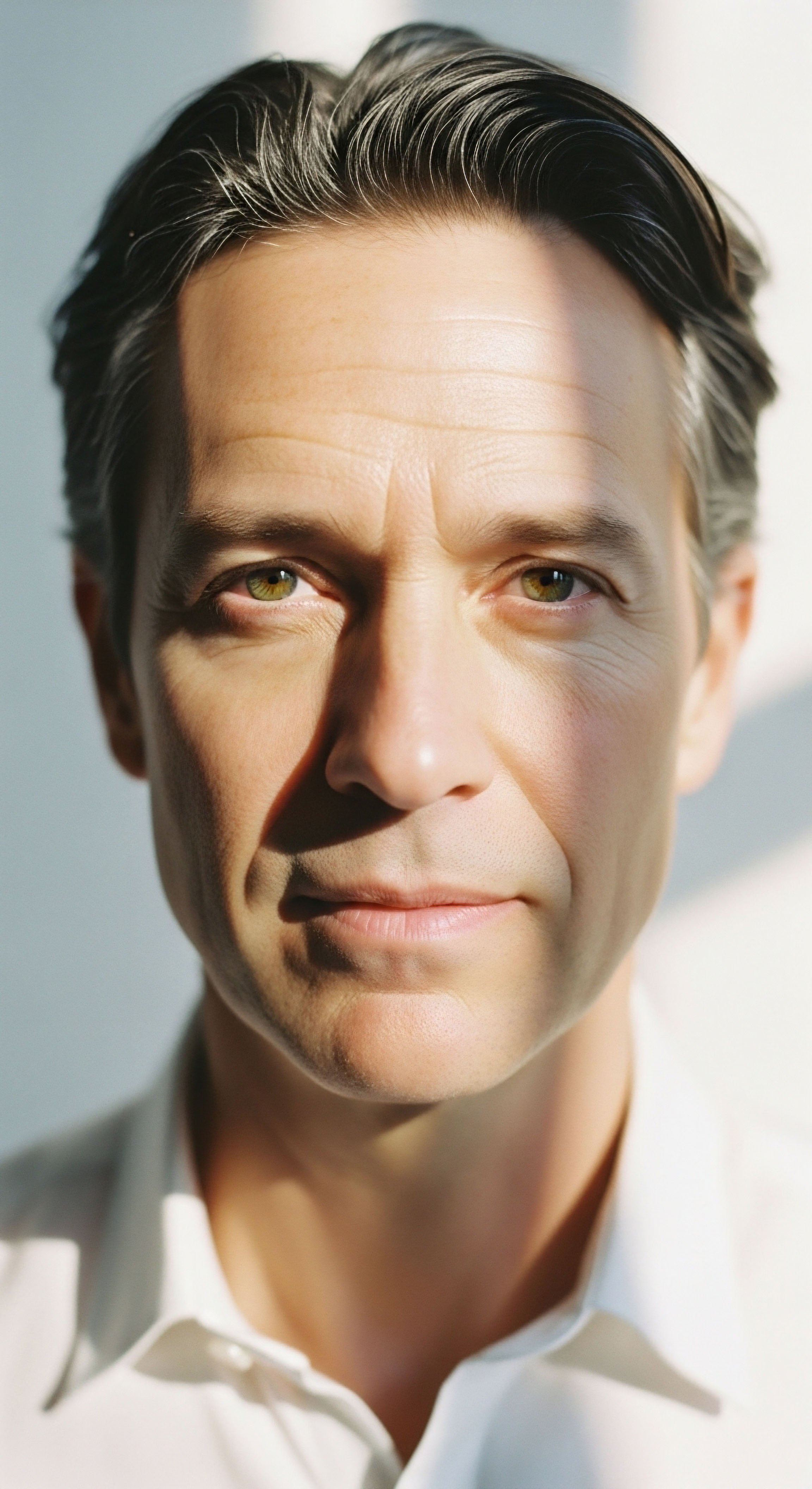

Fundamentals
You feel it as a subtle shift in your internal landscape. The energy that once defined your days seems less accessible, the sharp edge of your focus has softened, and a sense of vitality feels like a memory. In seeking to reclaim that function, the idea of testosterone therapy presents itself as a direct solution.
Your experience is valid; these changes are deeply felt and directly impact your quality of life. The impulse to correct what feels like a deficiency is a logical one. To truly understand the implications of this path, especially when pursued without clinical oversight, we must first appreciate the elegant, self-regulating system that governs this aspect of your biology.
Your body operates on a principle of intricate communication. At the heart of male hormonal health and reproductive capacity is a system known as the Hypothalamic-Pituitary-Gonadal (HPG) axis. This is your internal command structure. The hypothalamus, a region in your brain, acts as the chief executive, constantly monitoring your body’s needs.
It sends directives to the pituitary gland, its top manager. The pituitary, in turn, releases specific hormonal signals that travel through the bloodstream to the testes, the production centers. These signals, Luteinizing Hormone (LH) and Follicle-Stimulating Hormone (FSH), are the work orders that tell the testes to perform two critical jobs ∞ produce testosterone and generate sperm.
The body’s hormonal system functions as a tightly controlled feedback loop, where the brain directs testicular function based on circulating hormone levels.
This entire axis is a masterpiece of biological engineering, governed by a sensitive feedback loop. The hypothalamus and pituitary are constantly listening for the amount of testosterone in circulation. When levels are optimal, they reduce their signals. When levels are low, they increase them. This maintains a precise balance tailored to your system’s requirements.
When you introduce testosterone from an external source, the body does not differentiate its origin. The hypothalamus and pituitary detect high levels of circulating testosterone and interpret it as a sign that the production centers are overperforming. Their logical response is to cease sending the “work order” signals ∞ LH and FSH. Consequently, the testes’ own production lines are shut down. This shutdown is the central event that affects reproductive potential, a direct consequence of overriding the body’s innate regulatory wisdom.

How Does External Testosterone Disrupt Natural Processes?
The introduction of exogenous testosterone effectively silences the conversation between your brain and your gonads. The pituitary gland stops releasing LH and FSH, the two key hormones that stimulate the testes. Without the LH signal, the Leydig cells within the testes stop producing the body’s own testosterone.
Without the FSH signal, the Sertoli cells can no longer support the development and maturation of sperm, a process called spermatogenesis. The therapy might increase testosterone levels in your blood, addressing certain symptoms of low T, but it simultaneously creates a state of profound deficiency within the testes themselves, bringing sperm production to a halt.


Intermediate
Understanding the HPG axis as a communication network allows us to examine the specific messages that are disrupted by unmonitored testosterone therapy. The consequences for male fertility are not a side effect; they are a direct and predictable outcome of altering this system’s delicate signaling protocol. The process unfolds with biochemical certainty once the natural feedback loop is artificially overridden by an external supply of androgens.
The two primary messages sent from the pituitary gland, LH and FSH, have distinct yet synergistic roles. Luteinizing Hormone (LH) is the specific signal that stimulates the Leydig cells in the testes to produce testosterone. This locally produced, or intratesticular, testosterone reaches concentrations vastly higher than what is found in the bloodstream and is absolutely essential for sperm production.
Follicle-Stimulating Hormone (FSH) directly acts on Sertoli cells, which are the “nurse” cells of the testes, providing the structural and nutritional support required for sperm to mature. Unmonitored testosterone administration suppresses the release of both, leading to a state of hypogonadotropic hypogonadism, where low gonadotropin (LH and FSH) levels lead to testicular shutdown.
Exogenous testosterone suppresses the pituitary signals essential for both testicular testosterone production and sperm maturation.
This induced state is why exogenous testosterone has been studied as a potential male contraceptive. The body’s own testosterone factories close down, and with them, the adjacent assembly line for sperm. The severity of this shutdown correlates with the dose and duration of the unmonitored therapy. Higher doses and longer periods of use lead to a more profound and prolonged suppression of the HPG axis, making recovery of natural function a more significant clinical challenge.

Comparing Endogenous and Exogenous Testosterone Effects
The distinction between the body’s own hormonal regulation and the impact of an external source is critical. The following table illustrates the divergent paths these two scenarios create within the male reproductive system.
| Parameter | Endogenous Regulation (Healthy HPG Axis) | Exogenous Therapy (Unmonitored) |
|---|---|---|
| Hypothalamic Signal (GnRH) | Pulsatile release, responsive to bodily needs. | Suppressed due to high serum testosterone. |
| Pituitary Signals (LH & FSH) | Released in response to GnRH. | Severely diminished or absent. |
| Intratesticular Testosterone | Maintained at very high concentrations. | Drastically reduced to near-zero levels. |
| Spermatogenesis | Active and supported by FSH and high ITT. | Impaired or completely halted. |
| Testicular Volume | Maintained. | Reduced due to cellular inactivity. |

The Cascading Impact of Suppressed Gonadotropins
The shutdown of LH and FSH initiates a sequence of events that collectively compromise reproductive capacity. Recognizing this cascade is key to appreciating the systemic nature of the disruption.
- Cessation of Leydig Cell Function ∞ Without LH stimulation, Leydig cells become dormant. Their primary role of producing intratesticular testosterone ceases, removing a cornerstone of the spermatogenesis process.
- Impairment of Sertoli Cells ∞ Without FSH and the paracrine support from high local testosterone, Sertoli cells cannot properly nurture developing sperm cells, leading to maturation arrest.
- Reduction in Sperm Quality and Quantity ∞ The immediate result is a rapid decline in sperm count, motility, and morphology, often progressing to azoospermia, the complete absence of sperm in the ejaculate.
- Testicular Atrophy ∞ Over time, the lack of stimulation and cellular activity can lead to a noticeable decrease in testicular size, a physical manifestation of the internal shutdown.
Fortunately, clinical protocols exist to mitigate this. Therapies that use agents like Gonadorelin, which mimics the hypothalamic signal, or Selective Estrogen Receptor Modulators (SERMs) like Clomiphene, can stimulate the pituitary to maintain LH and FSH production even during testosterone therapy. These advanced, supervised strategies are designed to support systemic testosterone levels while preserving the vital functions of the HPG axis.


Academic
A sophisticated analysis of how unsupervised androgen administration impacts male fertility requires moving beyond systemic hormonal levels to the nuanced microenvironment of the seminiferous tubules. The central lesion created by exogenous testosterone is the stark decoupling of serum testosterone from intratesticular testosterone (ITT).
While serum levels may be elevated to therapeutic or even supraphysiologic ranges, ITT concentrations plummet. This localized androgen deficiency is the primary driver of spermatogenic failure, as the process requires ITT levels that are approximately 100-fold higher than those in peripheral circulation.
The regulation of spermatogenesis is a complex interplay between endocrine signals and local paracrine communication within the testes. Luteinizing Hormone (LH) and Follicle-Stimulating Hormone (FSH), the gonadotropins released from the anterior pituitary, are the conductors of this orchestra.
Exogenous androgens suppress the pulsatile release of Gonadotropin-Releasing Hormone (GnRH) from the hypothalamus, leading to a profound suppression of both LH and FSH secretion. This iatrogenic hypogonadotropic hypogonadism starves the testicular machinery of its essential stimuli. The Leydig cells, deprived of LH, cease producing ITT.
Concurrently, the Sertoli cells, deprived of both direct FSH stimulation and the critical paracrine support from Leydig cell-derived testosterone, are unable to fulfill their role in supporting germ cell development from spermatogonia to mature spermatozoa.
The primary insult of unmonitored testosterone use is the creation of a severe intratesticular androgen deficiency, despite high serum levels, leading to spermatogenic arrest.
This leads to a histological state of maturation arrest. While early-stage germ cells may be present, their progression through meiosis and spermiogenesis is halted. The duration and dosage of the unsupervised androgen use are critical variables determining the depth of suppression and the potential for recovery. Prolonged periods of testicular inactivity can lead to more persistent changes, including Leydig cell atrophy and potential alterations to Sertoli cell function, complicating future restoration efforts.

What Are the Pharmacological Pathways for Fertility Restoration?
The goal of fertility restoration post-androgen use is to re-engage the suppressed HPG axis. This is accomplished using agents that stimulate the system at different levels. The choice of protocol depends on the duration of suppression and the individual’s response. A foundational understanding of these interventions reveals a strategy of mimicking the body’s natural signaling cascade.
| Therapeutic Agent | Mechanism of Action | Primary Clinical Target |
|---|---|---|
| Gonadorelin / hCG | Acts as a GnRH analogue (Gonadorelin) or mimics LH (hCG) to directly stimulate the gonads. | Stimulate Leydig cells to resume intratesticular testosterone production. |
| Clomiphene Citrate (Clomid) | A Selective Estrogen Receptor Modulator (SERM) that blocks estrogen feedback at the hypothalamus and pituitary. | Increase endogenous production of GnRH, leading to increased LH and FSH release. |
| Tamoxifen | A SERM with a similar mechanism to clomiphene, often used for its favorable effects on the LH/FSH ratio. | Enhance pituitary output of gonadotropins. |
| Anastrozole | An Aromatase Inhibitor (AI) that blocks the conversion of testosterone to estradiol. | Reduce estrogenic negative feedback on the HPG axis, thereby increasing gonadotropin drive. |

What Factors Influence Spermatogenesis Recovery Timelines?
The recovery of spermatogenesis after cessation of unmonitored testosterone is not guaranteed and the timeline is highly variable. Several factors influence the prognosis for a return to fertility.
- Duration of Use ∞ Longer periods of HPG axis suppression generally require a longer recovery period. Chronic suppression may lead to more profound testicular changes that are slower to reverse.
- Dosage and Compound ∞ Supraphysiologic doses of androgens, common in unsupervised settings, cause a more profound and rapid shutdown of the HPG axis than therapeutic doses.
- Baseline Fertility Status ∞ An individual’s pre-therapy fertility status is a significant predictor. Men with robust baseline spermatogenesis have a better prognosis for full recovery.
- Age ∞ While not always a direct factor, age can be associated with a less resilient HPG axis, potentially slowing the recovery process.
- Ancillary Medication Use ∞ The implementation of a clinically supervised recovery protocol using agents like SERMs, hCG, or AIs can significantly shorten the time to recovery compared to spontaneous recovery alone.
The clinical approach, therefore, is rooted in a systems-biology perspective. It acknowledges that restoring fertility is about more than just stopping the offending agent; it is about actively restarting a dormant neuroendocrine system with targeted pharmacological inputs. This process requires careful monitoring of serum gonadotropins and semen parameters to titrate therapy and manage patient expectations effectively.

References
- Rahnema, C. D. Lipshultz, L. I. Crosnoe, L. E. Kovac, J. R. & Kim, E. D. (2014). Anabolic steroid-induced hypogonadism ∞ diagnosis and treatment. Fertility and Sterility, 101 (5), 1271 ∞ 1279.
- Bhasin, S. & Brito, J. P. (2022). Understanding and managing the suppression of spermatogenesis caused by testosterone replacement therapy (TRT) and anabolic ∞ androgenic steroids (AAS). Andrology, 10 (4), 639 ∞ 649.
- Patel, A. S. Leong, J. Y. Ramos, L. & Ramasamy, R. (2019). Testosterone is a Contraceptive and should not be used in men who desire fertility. The World Journal of Men’s Health, 37 (1), 45 ∞ 54.
- Wheeler, K. M. Smith, R. P. & Levine, L. A. (2016). Recovery of spermatogenesis following testosterone replacement therapy or anabolic-androgenic steroid use. Asian Journal of Andrology, 18 (3), 373 ∞ 380.
- De Vita, R. & D’Andrea, S. (2024). Management of Male Fertility in Hypogonadal Patients on Testosterone Replacement Therapy. Medicina, 60 (2), 299.
- Ramasamy, R. Armstrong, J. M. & Lipshultz, L. I. (2015). Preserving fertility in the hypogonadal patient ∞ an update. Asian Journal of Andrology, 17 (2), 197 ∞ 200.
- Walkers-Miller, A. & Bhasin, S. (2020). Pathophysiology, Diagnosis, and Treatment of Male Hypogonadism. The Journal of Clinical Endocrinology & Metabolism, 105 (10), dgaa416.
- Crosnoe-Shipley, L. E. et al. (2015). Treatment of Gonadotropin-Induced Deficiency of Spermatogenesis. The Journal of Clinical Endocrinology & Metabolism, 100 (3), 823-830.

Reflection
The information presented here offers a map of a specific biological territory, charting the pathways that govern male vitality and reproductive health. This knowledge is a powerful tool, shifting the conversation from one of simple deficiency and replacement to one of systemic balance and communication. Your body has an innate intelligence, a complex system of checks and balances refined over millennia. The desire to feel your best is the starting point of a significant health inquiry.
Consider the distinction between optimizing a system and overriding it. The path toward sustainable health and function involves working in concert with your body’s carefully orchestrated processes. This exploration of the HPG axis is an invitation to view your own biology with a new level of respect and curiosity.
The ultimate goal is not just a number on a lab report, but a state of integrated well-being. This understanding is the first, most critical step on a personalized path toward reclaiming your vitality, guided by a strategy that honors the profound complexity of your own biological design.



